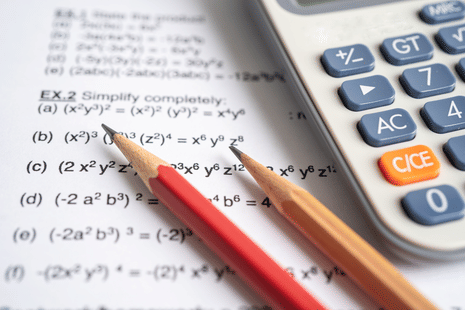
IIT JAM Mathematics is a national-level, annually conducted exam that tests your subject knowledge from an undergraduate program. In mathematics, you will be examined across key subject areas like Real Analysis, Linear Algebra, Calculus, and Differential Equations . IIT JAM Exam 2026 is being conducted by IIT Bombay and has been scheduled for February 15, 2026.
Once you qualify for the exam, you can become a part of academic and research opportunities and achieve better career growth. If you are a JAM 2026 aspirant, you must take a look at our deeply analyzed pool of repetitive question patterns and solution strategies by the experts. This article covers the top 10 IIT JAM Mathematics Questions based on previous year questions, expert video solutions, and preparation insights.
Also check: IIT JAM Mathematics Question Paper 2025
Question Selection Criteria & Topic Weightage
IIT JAM Mathematics Questions are selected after a careful analysis of IIT JAM Previous Year Question Paper . The selection is based on factors like topic recurrence every year, conceptual depth needed to solve problems, and overall weightage distributed across specific topics. Some of the important topics for IIT JAM Mathematics exam are: Real Analysis, Linear Algebra, and Calculus of a Single and Multiple Variables .
IIT JAM Mathematics Exam Pattern includes Multiple Choice Questions (MCQs), Multiple Select Questions (MSQs), and Numerical Answer Type (NAT) questions . This is to ensure that you are prepared for each type of question with appropriate problem-solving skills. To provide a clear understanding of which topics ask for more weightage, PYQs patterns based on an analysis of past papers are presented below.
Top 10 JAM Mathematics Questions with Expert-advised Answers
Question 1: What is the most common application of the Rank-Nullity Theorem in JAM?
Topic: Linear Algebra
Expert Tip: Take up solved problems to practice null space dimension calculations. Commonly analysed along with matrix transformations.
Answer Strategy: Solve using the basis of null space and column space.
Question 2: How are continuity and differentiability tested under Real Analysis?
Topic: Real Analysis
Expert Tip: Focus on piecewise functions and definitions. Limit definition of derivative is often tested.
Answer Strategy: Use ε-δ approach, analyze both sides.
Question 3: Which are the most asked sequence and series convergence tests?
Topic: Real Analysis
Expert Tip: Ratio test, root test, and comparison tests create the base. Regularly practice both alternating series and absolute convergence problems.
Answer Strategy: Apply ratio test for factorial/exponential terms, root test for nth power expressions, and comparison for rational functions.
Question 4: Explain the usual appearance pattern of eigenvalue and eigenvector problems in JAM Mathematics?
Topic: Linear Algebra
Expert Tip: Keep your Focus on characteristic polynomial calculation and diagonalization. Properly practice finding minimal polynomials and geometric multiplicities.
Answer Strategy: Structure characteristic equation det(A - λI) = 0, solve for eigenvalues, then find equivalent eigenvectors.
Question 5: What are the usually tested differential equation types?
Topic: Differential Equations
Expert Tip: You will need to Learn first-order separable, exact equations, and second-order linear equations with constant coefficients. Moreover, it is crucial to test and practice applying integrating factor methods.
Answer Strategy: Determine equation type first, then use the correct solution technique. Verify conditions for exactness in exact equations.
Question 6:How are multivariable calculus optimization problems framed?
Topic: Multivariable Calculus
Expert Tip: Keep your focus pertinent to Lagrange multipliers and critical point analysis. Analyze and keep practicing constrained optimization with boundary conditions.
Answer Strategy: Find and locate critical points via partial derivatives, and use a second derivative test to classify.
Question 7: What method is used to solve first-order linear differential equations?
Topic: Calculus / Differential Equations
Expert Tip: The usual form of a first-order linear differential equation, dxdy+P(x)y=Q(x) must be recognised. The goal is to find the integrating factor, μ(x)=e∫P(x)dx, which is set to change the left-hand side into the derivative of a product.
Answer Strategy: As you find the usual (standard) form of the equation, calculate the integrating factor μ(x). Multiply the entire equation by μ(x) to get the right equation, and combine both sides with x to find y. If an initial condition is mentioned, use it to find the constant of integration, C.
Question 8: How are volumes and surface areas calculated using multiple integrals?
Topic: Calculus
Expert Tip: Areas, volumes, and surface areas are completed using multiple integrals (double and triple integrals). These need to change in order of integration or switching to a different coordinate system. You must know the method of setting up the correct limits of integration. Moreover, the Jacobian is an important tool for coordinate transformations.
Answer Strategy: Visualise the area of integration as part of your answer strategy. To find the area of a double integral, set it up as ∬ R dA, where the region R's boundary determines the limits of integration. Set up a triple integral or a double integral of a function over a region, like ∬ D f(x,y)dA, to determine a volume.
Question 9: What is Lagrange's Theorem and how is it implemented for all groups?
Topic: Group Theory
Expert Tip: According to the theorem, if H is a subgroup of a finite group G, then the order of H must be a factor of the order of G. This is a strong limit. The order of any element a∈G must also be a factor of the order of G. To find all the possible subgroup orders, practise finding all the divisors of a group's order.
Answer Strategy: If in the problem, there is an order of a group, for instance, ∣G∣=n, and potential subgroups are being asked, you can directly put all positive divisors of n. The theorem entails these as the only possible orders for any subgroup of G.
Question 10: How to figure out if a provided group is cyclic?
Topic: Group Theory
Expert Tip: Cyclic groups can be formed via a single element. It is detrimental for group G to be cyclic if it includes the element a∈G with order n. The number of generators of a cyclic group of order n is given by ϕ(n), where ϕ is Euler's totient function.
So, a cyclic group with 'n' elements has ϕ(n) generators, where ϕ is what we call Euler's totient function.
Answer Strategy: A finite group G is called "cyclic" if it has an element 'a' whose "order" (how many times you have to apply the group operation to 'a' to get back to the identity) is the same as the total number of elements in the group, which is written as ∣G∣. For example, the group Zn (numbers 0 to n-1) with addition modulo n is a cyclic group of order n.
Topic-Wise Question Analysis from IIT JAM Maths Previous Papers
To help you focus your preparation strategically, the table below presents a topic-wise analysis of questions asked in the IIT JAM Mathematics exam over the past five years (2021–2025). It highlights high-weightage areas, recurring sub-topics, and their frequency in Previous Year Questions (PYQs). Use this data-driven insight to prioritize important chapters for maximum scoring potential.
Sections | Topic | Sub-Topics / Details | PYQ’s patterns (2025 - 2021) from important topics/sub-topics | Importance |
|---|---|---|---|---|
Real Analysis | Sequence & Series of Real Numbers | Convergence, Bounded/Monotone, Cauchy, Subsequence, Absolute Convergence, Comparison/Ratio/Root Test, Power Series (radius/interval), Term-wise Diff./Integration | Seq.: 5, 3, 4, 2, 3 Series: 6, 7, 3, 7, 2 | Very important |
Functions of One Real Variable | Limits, Continuity, Differentiability, IVP, Rolle’s, MVT, L’Hopital, Taylor’s, Max/Min | Limits: 4, 7, 2; Diff.: 4, 3, –, 4, 1 | important | |
Riemann Integration | Definite Integrals, FTC | Typically 1–2 Qs | Moderate | |
Multivariable Calculus & Differential Equations | Functions of Two/Three Variables | Limits, Continuity, Partial Derivatives, Differentiability, Max/Min | ~4–5 Qs | Important |
Integral Calculus | Definite Integrals (3, 2, 1, 3, 3), Area Under Curve (1, 2, 5, 2, 1), Surface Area & Volume Integrals, Double/Triple Integrals | Definite Integrals certain; AUC important | High | |
First Order DE | Bernoulli, Exact (≥1 Q), Integrating Factor (≥1 Q), Orthogonal Trajectory (~1 Q), Homogeneous, Variable Separable | 5, 4, 3, 2, 1 | Very important | |
Second Order LDE (Const. Coeffs.) | Variation of Parameters, Euler Eq. | Higher order: 2, 5, 2, 4, 1 | Important | |
Existence & Uniqueness | Rarely asked | Once in 3–4 yrs | Low | |
Algebra | Linear Algebra | Vector Spaces (4, 5, 3, 3, 2), Linear Transformation (2, 3, 4, 5), Rank/Inverse, Determinant, Systems (1–2 Qs, none in 2022), Eigenvalues (2 Qs recent years, 3 before), Cayley-Hamilton | Overall 20–22 marks | All topics important |
Group Theory | Groups/Subgroups, Abelian/Non-Abelian, Cyclic, Permutation/Symmetric (2, 3, 2, 5), Normal Subgroup (1–2 Qs), Lagrange’s, Homomorphism (1–2 Qs), Cosets, Sylow’s (last 2 yrs) | Permutation/Symmetric very important; Others moderate | High |
Expert Tips for IIT JAM Mathematics Exam Preparation
IIT JAM Mathematics exam preparation requires not only syllabus familiarity but to preparing with a strategy and in-depth comprehension of the complete subject. Below are some of the tips given by experts to help you prepare well and achieve the needed score for the JAM Mathematics exam to get into your aimed IITs, IIs, or some other JAM score-accepting institutes.
- Practice PYQs regularly with strategy: Ensure you practice past papers regularly. You will grasp not just the structure of the exam but also the pattern for the types of questions across all three sections of the paper. Moreover, while you perform the previous year papers for practice, make sure you do so under the actual exam’s 3-hour time frame, improving accuracy and pace.
- Daily Revision and Concept Clarity: Mathematics is a subject of interconnected concepts. Daily revision is crucial to ensure formulas, theorems, and key concepts stay fresh. Maintain a notebook for short notes, key formulas, and solutions to tricky problems. This is far more effective than trying to memorize everything at the last minute and helps build a strong foundational understanding.
- Daily revision: You must revise every day to ensure all the formulas, theorems and important concepts remain fresh. You can do so, for instance, by maintaining a notebook for notes, formulas, and solving tricky questions. This way, you won't need to memorize everything manually in the last days before an exam, and it will be memorized automatically with regular practice.
- Mock Tests: Mock papers practice helps to identify weak areas and redefine your strategy for attempting the paper. You can even then strategically divide how much time to give to a particular question on a strict basis.
After getting an MSc Degree in Mathematics through IIT JAM, you open up various career options. You can get into Data Science & Analytics, Actuarial Science, Teaching and Research, Finance and Banking, or you can take government exams for ISRO Scientist, RBI Grade B, SSC CGL, and UPSC. Ensure you prioritize high-weightage topics and practice through mock tests and PYQs for better concept clarity.
Also Check:
| Top 10 IIT JAM Physics Questions Answered by Experts | Top 10 IIT JAM Biotechnology Questions Answered by Experts |
|---|---|
| Top 10 IIT JAM Economics Questions Answered by Experts | Top 10 IIT JAM Chemistry Questions Answered by Experts |
Are you feeling lost and unsure about what career path to take after completing 12th standard?
Say goodbye to confusion and hello to a bright future!

FAQs
GATE Math is usually considered to be tougher than JAM. This is because JAM centers around the main undergraduate concepts while GATE asks for deeper application-based comprehension and problem-solving skills for a broader syllabus.
Real Analysis, Calculus, and Linear Algebra have the highest weightage in the JAM Mathematics exam. Practice and revise to ace in the IIT Jam exam.
Although direct JAM questions don't usually recur each year, the same usual concepts and question formats are regularly used. Understanding these trends, determining high-weightage topics, and improving time management.
The best approach to clear out JAM NAT questions quickly is: 1. follow a few syllabus-aligned strategies, such as being efficient at the key concepts and formulas of math. 2. Create a notebook for specific notes and a list of formulas to review and practice regularly. 3. Practice with a timer to improve your speed and accuracy. 4. Calculate the time for each question, and do not spend more than required in any of them. 5. Use a virtual calculator effectively.
Was this article helpful?





















Similar Articles
PSU Opportunities After Qualifying CSIR NET Exam
PSU Recruitment Process for CSIR NET-qualified Candidates
CSIR NET 2025 Application Form Correction: Check Dates, Process, Details to Edit
CSIR NET 2025 December Session: Steps to Retrieve Application Number & Password
CSIR NET E-Certificate: How to Download, Validity, Documents Required, Instructions
How to Prepare for CSIR NET in 3 months